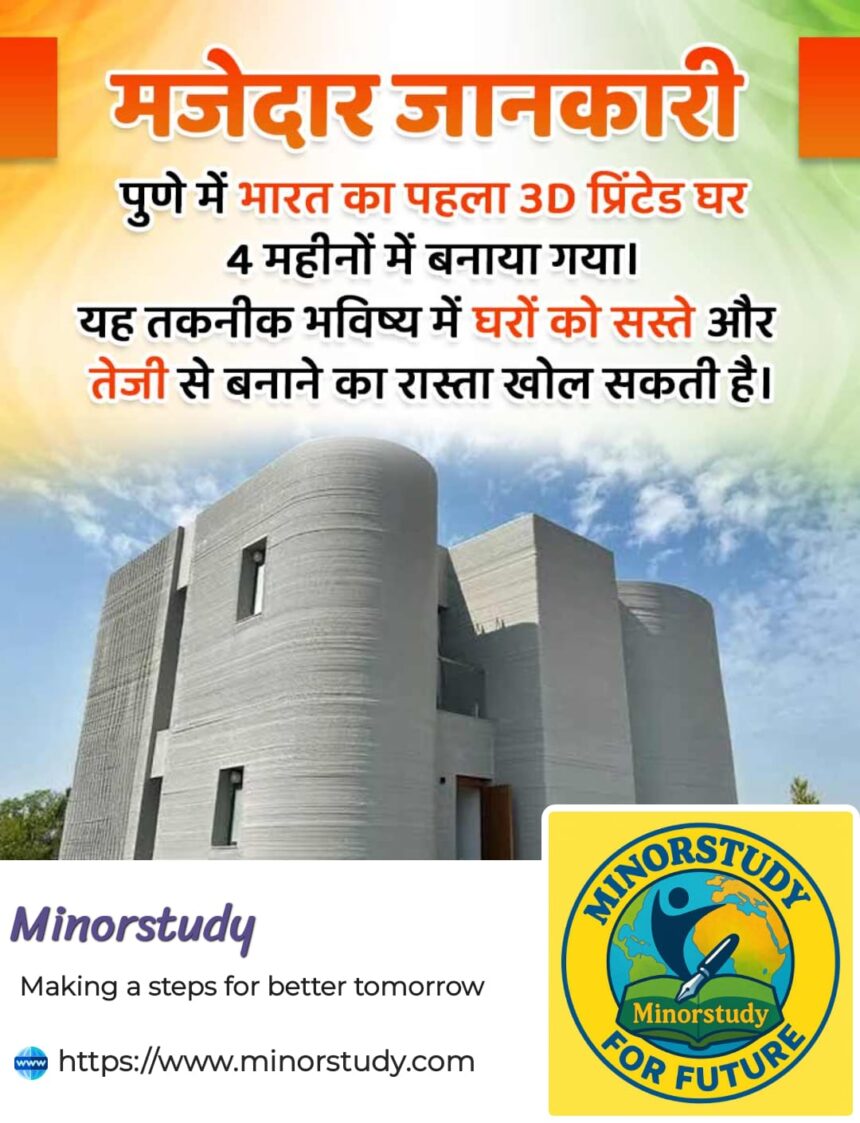🌟 Introduction: A New Chapter in Indian Housing
Imagine a world where your dream house is ready in just a few months, costs much less than traditional homes, and is built with cutting-edge technology. Sounds futuristic, right? Well, the future is already here!
- 🌟 Introduction: A New Chapter in Indian Housing
- 🏠 History of 3D Printed Houses in India
- 📊 Fun Facts About India’s First 3D Printed House
- ⏳ Timeline of Development
- 🌍 Significance of the 3D Printed House
- 🙌 Impact on Daily Life
- 💡 Important Points to Remember
- ❓ FAQs About India’s First 3D Printed House
- 🎉 Wishing & Messages
- 🧭 Why This Is Important to Society
- ✅ Conclusion
India’s first 3D printed house was built in Pune in just 4 months, and it marks a huge milestone in the country’s construction industry. This achievement not only demonstrates how technology can reshape lives but also opens the door to affordable, sustainable, and faster housing solutions for millions of people.
In this article, we’ll explore the history, timeline, facts, significance, impacts on daily life, FAQs, and inspiring messages about this groundbreaking innovation.
🏠 History of 3D Printed Houses in India
The concept of 3D printed homes began globally a decade ago, with experiments in Europe and the USA. India, known for embracing technology with cultural adaptability, caught up with this trend quickly.
2017-2019: Researchers and startups in India started studying 3D printing construction technologies.
2020: The idea of developing India’s first 3D printed house gained momentum.
2021-2022: IIT Madras and several startups worked on prototypes.
2023: Construction companies began developing affordable models for real-world use.
2025: India’s first fully functional 3D printed house in Pune was completed in just 4 months, setting a national record.
This history showcases India’s ability to adapt innovation not only for luxury housing but also for mass-scale affordability.
📊 Fun Facts About India’s First 3D Printed House
Location: Pune, Maharashtra.
Time Taken: Only 4 months (compared to 12–18 months in conventional housing).
Material Used: A special concrete-based mix compatible with 3D printing.
Cost Efficiency: 30-40% cheaper than traditional homes.
Sustainability: Minimal construction waste and reduced carbon footprint.
Durability: Designed to withstand Indian climate and seismic conditions.
Future Plan: Can be replicated for affordable housing, disaster relief shelters, and rapid urban development.
⏳ Timeline of Development
Conceptualization: 2020
Research & Material Testing: 2021–2022
Prototype Testing: 2023
Government & Industry Collaboration: 2024
Completion of Pune House: 2025 (within 4 months)
🌍 Significance of the 3D Printed House
The importance of this development can be seen at multiple levels:
1. Economic Significance
Reduces cost of construction by up to 40%.
Encourages startups and innovation in the construction sector.
2. Social Significance
Helps provide affordable housing to low-income families.
Can be used for disaster relief shelters during floods, earthquakes, or cyclones.
3. Environmental Significance
Less material wastage.
Lower carbon emissions compared to conventional methods.
4. Cultural Significance
Demonstrates India’s adaptability to global innovations while catering to local needs.
🙌 Impact on Daily Life
The average Indian family spends years saving for a house. 3D printing technology brings hope by:
Lowering home ownership costs.
Speeding up construction timelines – meaning families move in faster.
Reducing rental dependency.
Creating sustainable housing solutions in growing cities like Pune, Bangalore, and Delhi.
Helping rural communities with fast, durable, and cost-friendly homes.
This will directly improve the quality of life for countless families in the future.
💡 Important Points to Remember
India’s first 3D printed house is not just a project, but a movement towards affordable housing.
It can reshape urban planning.
The technology is scalable and can be applied to schools, hospitals, and offices too.
It proves that India is on the global innovation map in housing technology.
❓ FAQs About India’s First 3D Printed House
Q1. How long does it take to build a 3D printed house?
➡️ The Pune house was built in 4 months; future projects may take even less time.
Q2. Is a 3D printed house safe?
➡️ Yes, it is designed with durable materials that withstand weather and seismic conditions.
Q3. Is it cheaper than traditional houses?
➡️ Absolutely! It saves 30–40% of costs.
Q4. Can this be scaled for mass housing projects?
➡️ Yes, the government and private sector are exploring this possibility.
Q5. Who built the first 3D printed house in India?
➡️ A collaboration between tech startups, construction companies, and researchers in Pune.
🎉 Wishing & Messages
“May this innovation inspire more affordable homes for every Indian family.”
“Pune’s 3D printed house is not just a building, but a dream made real with technology.”
“The future of Indian housing is here – faster, smarter, and greener!”
🧭 Why This Is Important to Society
Housing is a basic human need, and India faces a huge shortage of affordable homes. By introducing 3D printed houses:
Millions of homeless or low-income families could finally own a home.
Cities can solve slum challenges by replacing them with cost-effective, durable housing.
Emergency shelters during natural disasters can be ready within days instead of months.
This makes it one of the most impactful innovations for society in recent years.
✅ Conclusion
India’s first 3D printed house in Pune is more than just a technological marvel—it’s a symbol of hope for a better tomorrow. By making homes cheaper, faster, and sustainable, this technology promises to change the way we think about construction and housing.
From reducing costs to protecting the environment and ensuring shelter for all, 3D printing is truly the future of housing in India. As this movement grows, we might soon live in a world where every family, regardless of income, can proudly say—this is our home.









Great post, I conceive people should larn a lot from this web blog its really user friendly.